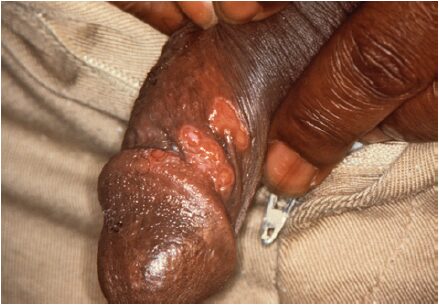Syphilis: Agent, Epidemiology, Symptoms, Treatment and Prevention
What is Syphilis?
- Syphilis Is a Chronic, Infectious Disease, Over the centuries, Europeans have had to contend with four pox diseases: chickenpox, cowpox, smallpox, and the Great Pox, the latter now known as syphilis.
- The first European epidemic was recorded in the late 1400s, shortly after the conquest of Naples by the French army.
Causative Agent and Epidemiology
- Syphilis is caused by Treponema pallidum, (trepo = “turn”; nema = “thread”; pallid = “pale”; thus literally “pale turning thread”).
- This spirochete moves by means of endoflagella.
- Humans are the only host for T. pallidum, so the organism must spread by direct human-to-human contact, usually during sexual intercourse.
- Syphilis is currently ranked among the top five most-reported microbial diseases in the United States.

- In 2014, the rate of reported cases was the highest since 1994.
- Statistics indicate more than 12 million cases are reported each year worldwide, with more than 90% of cases being in men.
- These figures suggest the magnitude of the syphilis epidemic, but some public health microbiologists believe that for every case reported, as many as nine cases go unreported.
- The cells of T. pallidum can evade immune defenses because the pathogen has very few surface proteins that the immune system can recognize.
- This invisibility allows the pathogen to persist in the body.
- The pathogen invade the skin surface through the mucous membranes of the genitalia or via a wound, abrasion, or hair follicle.
- The variety of clinical symptoms with the stages, and their similarity to different diseases, have led some physicians to call syphilis the “great imitator.”
- Untreated, the disease can progress through a number of stages, which can overlap.
Clinical Symptoms
The incubation period for syphilis varies greatly (10 to 90 days), but it averages about 3 weeks.
Primary Syphilis
- A lesion, called a chancre, which is a painless circular, purplish ulcer with a small, raised margin with hard edges is typical of primary syphilis.

- The chancre develops at the location of entry of the spirochetes, often the genital organs. any area of the skin can be affected, including the pharynx, rectum, or lips.
- It continues for 3 to 6 weeks and then heals automatically.
- The infection has not been wipe out, as the spirochetes have spread through the blood and lymph to other body organs.
Secondary Syphilis
- Several weeks after the chancre of primary syphilis has healed, the patient develops a fever and a flu-like illness as well as swollen lymph nodes.
- With secondary syphilis, a skin rash develops, which can be mistaken for measles, rubella, or chickenpox. The rash appears as reddish-brown spots on the palms, face, and trunk.

- Transmission can occur if there are moist lesions.
- In untreated patients, the symptoms of secondary syphilis resolve after several weeks.
- Most patients recover, but they bear pitted scars from the healed lesions and remain “pockmarked.”
- In 2014, there were 20,000 cases of primary and secondary syphilis reported to the CDC.
- Many patients will have relapses of secondary syphilis during which time they remain infectious.
- Within 4 years, the relapses cease and the disease is no longer infectious (except in pregnant females).
- Patients either remain asymptomatic or slowly progress to the third stage.
Tertiary Syphilis
- About 40% of untreated patients develop tertiary syphilis. This stage occurs in many forms, but most commonly, it involves the skin, skeletal, or cardiovascular and nervous systems.
- The hallmark of tertiary syphilis is the gumma, a soft, painless, gummy noninfectious granular lesion.

- In the cardiovascular system, gummas weaken the major blood vessels, causing them to bulge (aneurysm) and burst, whereas in the spinal cord and meninges, gummas lead to deterioration of the tissues and paralysis.
- In the brain, they alter the patient’s personality and judgment and cause insanity so intense that for many
generations, people with tertiary syphilis were confined to mental institutions (but read the chapter introduction). - Damage can be so serious as to cause death.
Congenital syphilis
- Congenital syphilis is a serious problem in pregnant women because the Treponema spirochetes penetrate the placental barrier after the third or fourth month of pregnancy.
- Infection in the fetus can lead to death (still birth); surviving infants can develop skin lesions and open sores.
- Affected children often suffer poor bone formation, meningitis, or Hutchinson’s triad, a combination of deafness, impaired vision, and notched, peg-shaped teeth.
- In 2014, there were nearly 460 congenital syphilis cases reported to the CDC.
Treatment and Prevention
- There is no immunity that develops from a prior infection and no vaccine for syphilis.
- Therefore, the cornerstone of syphilis control is safe sex practices and the identification and treatment of the sexual contacts of patients.
- Penicillin is the drug of choice, and a single dose usually is sufficient to cure primary and secondary syphilis.
- T. pallidum cannot be cultivated on laboratory media, diagnosis of the primary infection depends on the observation of spirochetes from the chancre using fluorescence or dark-field microscopy.

- As the disease progresses, a number of tests to detect syphilis antibodies become useful, including the Venereal Disease Research Laboratory (VDRL) test for syphilis screening and the newer rapid plasma reagin (RPR) test for screening and monitoring of syphilis.
Reference and Sources
- https://quizlet.com/206622057/microbiology-exam-4-flash-cards/
- https://healthjade.com/syphilis/
- https://encyclopedia2.thefreedictionary.com/endemic+syphilis
- https://quizlet.com/8472395/chapter-13-flash-cards/
- http://taggedwiki.zubiaga.org/new_content/459ead098bb4859f12690c0f932788b7
- https://emedicine.medscape.com/article/229461-treatment
- https://www.sciencedirect.com/topics/nursing-and-health-professions/dark-field-microscope
